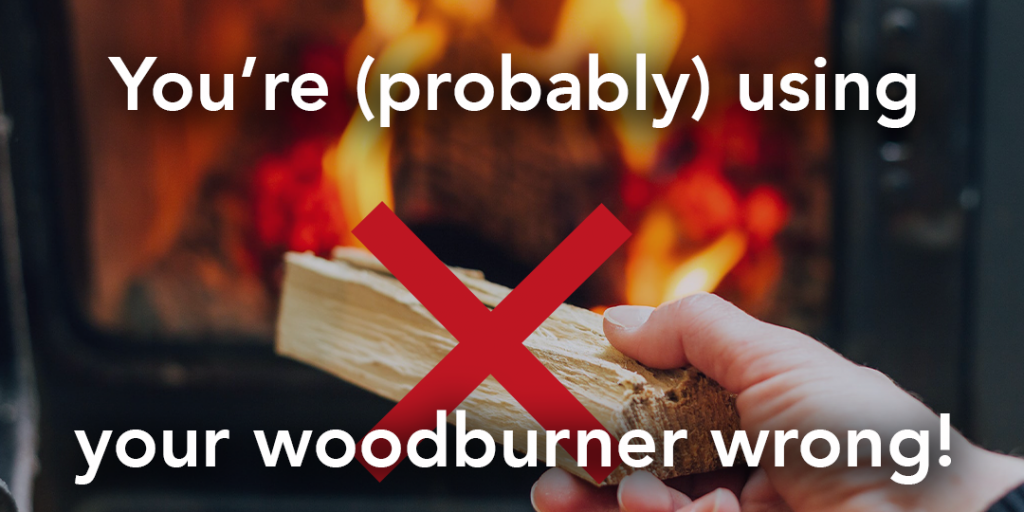As a chimney sweep, you can imagine just how many woodburners I see on a day-to-day basis. What might surprise you is that almost everyone fails to use their woodburner as efficiently as possible. In today’s blog, I’m going to go through some of the helpful tips and tricks I tell my customers to help them get the most out of their stoves. My clients routinely report around a 25% reduction in their wood consumption after changing their techniques, and you can do the same too!
My stove works fine. Why do I need to change anything?
Even if your stove appears to be operating well, there are often small adjustments that can significantly enhance its performance and efficiency. These adjustments not only save you money on wood but also contribute to a cleaner burn and reduce the environmental impact of your heating.
The key lies in understanding how to optimise the combustion process. Many woodburner users unknowingly restrict airflow or overload the stove, which can lead to inefficient burning, excessive smoke, and wasted fuel. By making simple changes to how you operate your woodburner, you can achieve a more consistent and efficient burn.
Lighting your fire:
The number one mistake people make when lighting their stoves is being far too stingy on kindling. Until your stove reaches its operating temperature, the gases from your wood (where most of the heat is stored) will not have enough energy available to them to react with the supplied oxygen and efficiently combust. People are often conscious of the amount of kindling they are using and try to reduce this to lower their running costs. Unfortunately, this approach results in wasting the heat of your logs in exchange for reducing small amounts of kindling. We’ve all heard the phrase “penny wise but pound foolish.”
We have already covered the best method for lighting your fire in this blog post here for those who would like to ace the first step of using their stove.
Fuel used
Thankfully, this is not something I come across all that frequently, but I have seen the residues left in chimneys after stove users choose to use their woodburners as garbage incinerators. It may seem like a good idea to dispose of sweet wrappers, glossy magazines or used fruit peels in your stove, but non-recommended fuels can add sticky residues to the inside of your chimney, increasing your chances of having a chimney fire. Not to mention, burning plastic is highly toxic and to be avoided at all costs.
Remember to burn wood which has a moisture content of 20% or less. Given the weather this past six months, many people have begun to struggle with wetter wood as the fibrous material takes in moisture from the humid air. Storing your wood in a sheltered, well-ventilated place will give you the best results and provide the added benefit of increased efficiency. The drier the wood, the hotter it will burn and therefore the less of it you will need! Aim to use wood with around 10% moisture content. You can check the content of your own supply using a moisture meter.
‘Listen’ to your stove
Your stove is great at telling you what it needs. Did you know that black stove glass is a symptom of misuse and is not supposed to be present in the use of your appliance? A well-functioning wood burner should retain near crystal-clear stove glass as standard. I usually only need to clean my own every couple of weeks and even then, I remove only a small line of brown from the bottom of the glass.
If your stove glass is turning black or getting dirty, simply open the air vent until it clears and leave it there. You may feel like you’re going through your wood quicker; however, woodburner efficiency is actually quite counterintuitive. As the wood in the stove needs oxygen to burn, supplying more air to your stove allows you to get more heat from each log. Even though each log won’t last quite as long, each piece of wood will give off much more heat compared to if you had starved it of oxygen, which leads to needing to burn less wood over the day, reducing the overall consumption of your stove by a staggering amount.
Once your stove glass is nice and clear, take a look at the flames coming off the wood. You are aiming for a nice, bright, and lively yellow flame. Duller red or orange flames, or even worse, seeing wisps of smoke, are to be avoided at all costs. Open up your air vent until you can consistently retain a yellow flame combined with clear stove glass and then learn to regulate how much wood you need in your stove to achieve this. No doubt, it will be less than you think!
Conclusion
Each stove and its operation is slightly different. Only you will know how your particular stove performs in its particular location, but the tips and tricks provided above are universal to all systems. Find the sweet spot for your own stove with your air vent position and remember to get your chimney swept regularly to keep your system safe and as efficient as possible. Ensuring proper kindling usage, selecting the right fuel, and listening to the feedback from your stove will not only save you money but also contribute to a cleaner, safer, and more environmentally friendly home heating solution.





